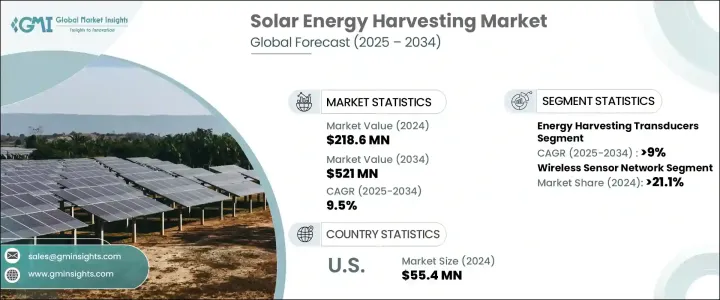PUBLISHER: Global Market Insights Inc. | PRODUCT CODE: 1721588

PUBLISHER: Global Market Insights Inc. | PRODUCT CODE: 1721588
Solar Energy Harvesting Market Opportunity, Growth Drivers, Industry Trend Analysis, and Forecast 2025 - 2034
The Global Solar Energy Harvesting Market was valued at USD 218.6 million in 2024 and is estimated to grow at a CAGR of 9.5% to reach USD 521 million by 2034. As the global push toward sustainable energy intensifies, solar energy harvesting technologies are rapidly emerging as critical components in the clean energy transition. With mounting concerns over climate change, energy security, and fossil fuel depletion, solar energy continues to attract attention for its long-term viability and minimal environmental footprint. Advances in photovoltaic (PV) technology, combined with decreasing costs of solar modules and inverters, have positioned solar energy harvesting systems as practical and affordable solutions for diverse applications. The market is experiencing robust interest from residential users, industrial players, and governmental bodies alike, spurred by policy incentives, tax credits, and an increasing preference for decentralized power systems. Additionally, the integration of AI, IoT, and real-time monitoring capabilities into solar systems is enhancing performance and making solar energy more adaptable to dynamic user demands. This momentum is also being reinforced by the growing prevalence of microgrids and the need for off-grid solutions in remote locations.

Ongoing advancements in solar panel technologies and energy storage systems continue to increase overall system efficiency while significantly reducing the payback period. These innovations are accelerating the widespread adoption of solar energy across residential, commercial, and industrial sectors. Both government entities and private institutions remain actively involved in promoting the transition to clean energy. Coupled with the declining prices of solar components, solar harvesting systems are becoming increasingly accessible and financially viable for a wider user base. As the global appetite for renewable and self-sustaining power sources rises, the market is drawing attention from both emerging players and established industry giants seeking to expand their portfolios.
| Market Scope | |
|---|---|
| Start Year | 2024 |
| Forecast Year | 2025-2034 |
| Start Value | $218.6 Million |
| Forecast Value | $521 Million |
| CAGR | 9.5% |
Among the key components, energy harvesting transducers are witnessing increasing demand due to their ability to convert sunlight into usable electricity even under harsh environmental conditions. Their durability and capacity to perform in extreme temperatures or rugged terrains allow solar technologies to penetrate previously unreachable markets. These transducers facilitate uninterrupted, off-grid energy generation with minimal maintenance, making them ideal for use in mobile and remote deployments where conventional systems fall short.
Wireless sensor networks accounted for a 21.1% market share in 2024, with solar energy harvesting enabling extended functionality without the need for battery replacements. This makes them highly suitable for industrial automation, environmental monitoring, and smart city infrastructure. In consumer electronics, solar-powered devices such as wearables, smartphones, and laptops offer added value through self-charging capabilities and reduced maintenance. As awareness around sustainability grows, solar-enabled consumer devices are carving out a niche in the eco-friendly tech segment.
The U.S. Solar Energy Harvesting Market reached USD 55.4 million in 2024, supported by favorable tax incentives, rebate programs, and ongoing investment in smart grid integration and solar cell innovation. Leading companies in the market-including ZF Friedrichshafen AG, ABB, Perpetua Power, Powercast Corporation, Honeywell, Texas Instruments Incorporated, and STMicroelectronics-are focusing on innovation in micro-energy technologies, compact transducer designs, and partnerships with OEMs and IoT developers to drive growth across applications such as building automation, industrial control, and connected consumer products.
Table of Contents
Chapter 1 Methodology & Scope
- 1.1 Market definitions
- 1.2 Base estimates & calculations
- 1.3 Forecast calculation
- 1.4 Data sources
- 1.4.1 Primary
- 1.4.2 Secondary
- 1.4.2.1 Paid sources
- 1.4.2.2 Unpaid sources
Chapter 2 Executive Summary
- 2.1 Industry synopsis, 2021 - 2034
Chapter 3 Industry Insights
- 3.1 Industry ecosystem analysis
- 3.2 Regulatory landscape
- 3.3 Industry impact forces
- 3.3.1 Growth drivers
- 3.3.2 Industry pitfalls & challenges
- 3.4 Growth potential analysis
- 3.5 Porter's analysis
- 3.5.1 Bargaining power of suppliers
- 3.5.2 Bargaining power of buyers
- 3.5.3 Threat of new entrants
- 3.5.4 Threat of substitutes
- 3.6 PESTEL analysis
Chapter 4 Competitive Landscape, 2024
- 4.1 Introduction
- 4.2 Strategic dashboard
- 4.3 Innovation & sustainability landscape
Chapter 5 Market Size and Forecast, By Component, 2021 - 2034 (USD Million)
- 5.1 Key trends
- 5.2 Energy harvesting transducer
- 5.3 Power management integrated circuit
- 5.4 Others
Chapter 6 Market size and Forecast, By End Use, 2021 - 2034 (USD Million)
- 6.1 Key trends
- 6.2 Wireless sensor networks
- 6.3 Consumer electronics
- 6.4 Building automation
- 6.5 Automotive
- 6.6 Others
Chapter 7 Market Size and Forecast, By Region, 2021 - 2034 (USD Million)
- 7.1 Key trends
- 7.2 North America
- 7.2.1 U.S.
- 7.2.2 Canada
- 7.3 Europe
- 7.3.1 Germany
- 7.3.2 France
- 7.3.3 UK
- 7.3.4 Spain
- 7.3.5 Italy
- 7.4 Asia Pacific
- 7.4.1 China
- 7.4.2 India
- 7.4.3 Japan
- 7.4.4 Australia
- 7.4.5 South Korea
- 7.5 Middle East & Africa
- 7.5.1 Saudi Arabia
- 7.5.2 South Africa
- 7.5.3 UAE
- 7.6 Latin America
- 7.6.1 Brazil
- 7.6.2 Argentina
Chapter 8 Company Profiles
- 8.1 ABB
- 8.2 Advanced Linear Devices, Inc.
- 8.3 Cedrat technologies
- 8.4 EnOcean GmbH
- 8.5 Fujitsu
- 8.6 Honeywell
- 8.7 Kinergizer
- 8.8 Laird Connectivity
- 8.9 Mide Technology Corp.
- 8.10 Mouser Electronics
- 8.11 Perpetua Power
- 8.12 Powercast Corporation
- 8.13 Renesas Electronics Corporation
- 8.14 STMicroelectronics
- 8.15 Texas Instruments Incorporated
- 8.16 ZF Friedrichshafen AG




